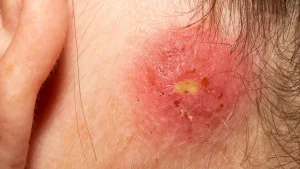Staph Infections are caused by a group of bacteria called staphylococcui that can affect various parts of the body. They are generally found on the skin or in the nose of even healthy people. Most of the time, such bacteria cause no issues or result in relatively minor skin infections.
It can turn serious if the infection spreads deep inside the tissues entering the systemic circulation, joints, lungs, heart, and other organs. Treatment usually involves antibiotics with draining of fluid from the affected area.
Symptoms
Depending on the site of infection, different forms of infection can occur.
Boils- is the most common infection, where pus gets formed in a hair follicle or oil gland , inducing the infected area to swell and become red. These boils usually happen near the groin and buttock area or inside the armpits.
Impetigo- It exhibits rash-like symptoms forming blisters that ooze fluid or pus, -forming a crust around the infected area.
Cellulitis– Cellulitis is an infection that spreads to deeper layers of the skin resulting in swelling and redness on the surface of the skin and may cause oozing of pus .
Staphylococcal skin syndrome- The toxins produced during the infection can cause fever and blisters in children and babies with exfoliation of the top layer of skin.
Food poisoning– It is the most common infection caused by staphylococcus when we eat contaminated food. It causes symptoms like diarrhea, dehydration, vomiting, nausea, etc.
Septic arthritis– It causes knees, shoulder joints, fingers, toes to swell with severe pain frequently leading to fever.
Toxic shock syndrome- The toxins produced during the infection can cause high-grade fever, rash, vomiting, nausea, mental confusion, aches in the body, diarrhea, abdominal pain. This life-threatening condition is caused by toxins produced by few strains of staph bacteria and are assoacited with certain types of tampons, skin wounds and surgery.
Bacteremia- It is the infection of systemic circulation where the bacteria enter the bloodstream causing fever and low blood pressure. It can also affect other internal organs like the brain, lungs, heart, bones, muscles.
Causes
Humans generally carry bacteria on their skin but do not develop infection instantly. These bacterias are also transferable from person to person, even from surface to person, as these staph bacteria easily survive in dry and extreme temperatures.

When to see a doctor
One should see the doctor if you have symptoms such as skin redness with irritation and pain, pus-filled blisters with fever, etc.
Your doctor will perform a physical examination of the infected area and collect skin samples for the lab to confirm a staph infection. The doctor may run few more tests to check the infection spread in the body depending on the symptoms.
Prevention
You can take few precautionary measures to avoid staph infections, such as:
Handwashing- Washing your hands is the best defence against any microbe. You can also use sanitizers (alcohol-based). Wash hands before and after eating, after using the bathroom, touching waste, etc.
Food safety- Storing hot and cold food appropriately , refrigerating the leftovers, washing utensils, cutting boards, tabletops, etc.
Hygienic use of personal items like towels, razors, sheets, clothing, or any other material without sharing .
Washing and drying of clothes regularly to get rid of bacteria.
If one has some injury, take care of that wound by dressing it regularly and keeping it covered.
Tampons- Tampons left for a long time cause infection. Change tampons frequently or shift to sanitary pads and change them every 6 hours.
Risk factors and complications
Individuals with weaker immune systems and those with diabetes, HIV, kidney failure, respiratory illness, etc are more vulnerable to staph infections . Staph infections can also be caused by invasive devices used during hospitalization example-Dialysis tubing, catheters, feeding tubes. Bacterias can travel along with the tubing and reach the inner organs. Also, consuming insanitary food by a vendor who is a carrier of staph bacteria can cause infection. Complications with a staph infection are that if the bacterias reach the systemic circulation, it can cause life-threatening septic shock .

Treatment
Staph infection can get treated with antibiotics. Various antibiotics They can be oral or topical. In case of skin infection, your wound gets dressed, and pus is drained.







